Aruba and St. John (U.S. Virgin Islands) offer contrasting island charms, each with its unique appeal that captivates travelers seeking a memorable getaway.
Aruba boasts a picturesque desert landscape, bathed in year-round sunshine, where vibrant cultures blend to create a diverse experience. St. John, on the other hand, enchants visitors with its lush tropical scenery, tranquil beaches, and rich African heritage. Whether you’re drawn to Aruba’s lively cultural scene, exhilarating water activities, and desert exploration or St. John’s secluded beaches, historical ruins, and immersive natural encounters, both islands promise an unforgettable escape.
LocationSouthern Caribbean, near the coast of VenezuelaCaribbean, east of Puerto Rico
GeographyFlat and arid with desert-like landscapesHilly and lush with tropical rainforests
LanguageOfficial languages: Dutch, PapiamentoOfficial language: English
GovernmentParliamentary democracy within the Kingdom of the NetherlandsUnincorporated territory of the United States
CurrencyAruban florin (AWG)United States dollar (USD)
TourismMajor tourist destination known for its white-sand beaches and water sportsPopular destination for nature lovers and snorkelers
EconomyRelies heavily on tourism and hospitality industryTourism, retail, and services are key economic sectors
CultureDiverse cultural heritage influenced by Dutch, African, and Latin American traditionsBlend of American and Caribbean cultures
AttractionsNatural wonders (Arikok National Park, Natural Pool), Oranjestad (capital city), Palm BeachVirgin Islands National Park, Trunk Bay Beach, Cruz Bay, Coral Bay
ClimateTropical climate with constant trade winds and little seasonal temperature variationTropical climate with warm temperatures throughout the year and wet and dry seasons
From cultural experiences to beach adventures, accommodation choices to tantalizing local flavors, and nature explorations to outdoor adventures, this article presents a comprehensive guide to help you choose your perfect island retreat.
Location and Geography: Contrasting Island Charms
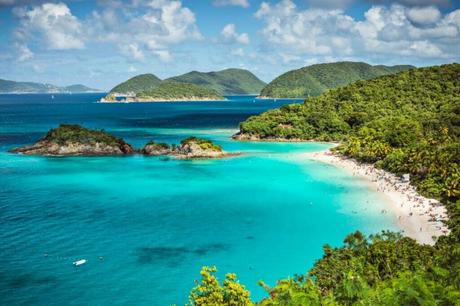
Aruba, one of the Lesser Antilles in the Southern Caribbean Sea, offers a flat, river-less landscape, adorned with distinct cacti-studded desert terrain contrasting with its breathtaking coastline. Aruba’s location just off the coast of Venezuela ensures warm, sunny weather virtually all year-round, as it lies outside the hurricane belt.
St. John, the smallest of the U.S. Virgin Islands, lies in the Caribbean to the east of Puerto Rico. Unlike Aruba, St. John boasts a hilly, lush tropical landscape, with its National Park covering approximately 60% of the island. Experiencing a tropical climate, it can occasionally fall within the hurricane belt, although its picturesque setting is hard to resist.
Aruba’s geographical position brings a blend of cultural influences from South America and the Caribbean. This southern gem has a more desert-like atmosphere, which gives it an uncommon beauty among Caribbean islands. Not to mention, the year-round fair weather enhances its allure to visitors.
On the other hand, St. John, with its verdant hills, hidden coves, and crystal-clear waters, provides a tropical paradise feel. The island’s location in the northern region of the Lesser Antilles attracts those seeking an escape amidst nature and tranquility.
Cultural Experiences: Aruba vs. St. John (U.S. Virgin Islands)

Aruba is a melting pot of more than 90 nationalities, reflecting in its vibrant culture. Its Dutch colonial heritage is evident in the pastel-hued architecture in its capital, Oranjestad. The island’s African and indigenous Indian roots add to its rich tapestry, with local music genres like soca, calypso, and tumba creating an energetic vibe.
St. John, on the other hand, holds a deep-rooted African influence, dating back to its days as a Danish sugar colony. The influence is palpable in its traditional music, dance, and food. Moreover, its National Park offers a journey into the island’s historical ruins, allowing visitors to immerse themselves in the island’s colonial past.
The cultural experience in Aruba is one of diversity, from traditional dance performances to the local handicraft markets. A visit to the Archeological Museum can enlighten visitors about the island’s ancient history. Local festivals, like Carnival and Dia di San Juan, add vibrancy to the island’s culture.
St. John’s cultural experience centers around the Virgin Islands National Park, where visitors can delve into the island’s history, visiting sugar plantation ruins and petroglyphs from the island’s first inhabitants. Cultural festivals, like the St. John Carnival, also provide a glimpse into local customs and traditions.
Beaches and Water Activities: A Comparative Guide
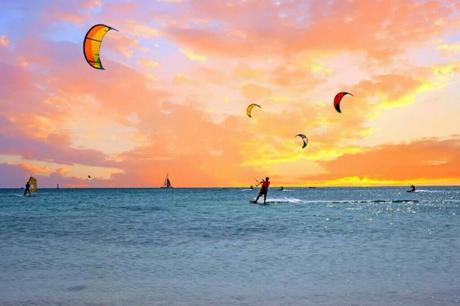
Aruba’s Palm Beach and Eagle Beach are world-renowned, offering soft white sands and crystal-clear waters, perfect for swimming and snorkeling. Aruba’s robust trade winds make it a haven for windsurfing and kiteboarding enthusiasts. The Antilla Shipwreck, a popular dive spot, allows for exploration of the rich marine life.
St. John’s beaches, including Trunk Bay and Cinnamon Bay, are equally inviting. These are perfect spots for sunbathing, swimming, and snorkeling, with an underwater snorkeling trail at Trunk Bay, offering an experience like no other. St. John’s waters also brim with vibrant coral reefs, offering fantastic scuba diving opportunities.
Aruba’s beach experience is complemented by beachside bars and restaurants, water sports rental facilities, and alluring sunset views. The island’s south side also offers rugged coastline views and natural pools, accessible through off-road adventures.
While St. John’s beaches are more secluded and tranquil, with pristine sands and waters protected by the National Park, ensuring an unspoiled experience. Kayaking in its calm bays and hiking trails leading to hidden beaches add to the island’s unique beach and water activities.
Accommodation and Hospitality: Finding Your Ideal Island Retreat
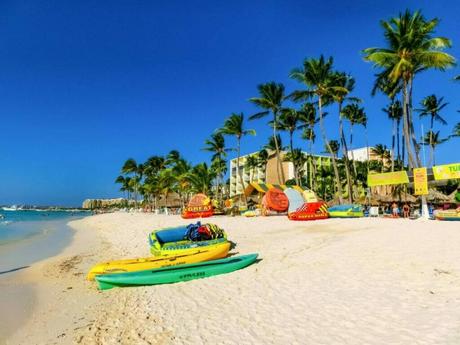
Aruba offers a wide range of accommodation options, from all-inclusive luxury resorts along Palm Beach to boutique hotels and vacation rentals. Aruban hospitality is renowned, with its friendly locals and high repeat visitor rate attesting to the quality of service.
St. John, although smaller, doesn’t lack in accommodation choices. From eco-friendly resorts to luxury villas and vacation rentals, there’s something for everyone. Its hospitality is marked by a laid-back charm and warm, friendly service that gives you a home-away-from-home feeling.
In Aruba, accommodation mostly lies along the island’s northwest coast, offering spectacular beach views. The high-rise area boasts big-name resorts, while the low-rise area offers more intimate accommodation options, both ensuring excellent service and comfort.
St. John’s accommodations are intertwined with nature, offering serene and stunning surroundings. The absence of big resorts contributes to the island’s tranquility, with smaller inns and private villings providing an intimate island experience.
Gastronomy and Local Flavors: Aruba and St. John (U.S. Virgin Islands) Compared
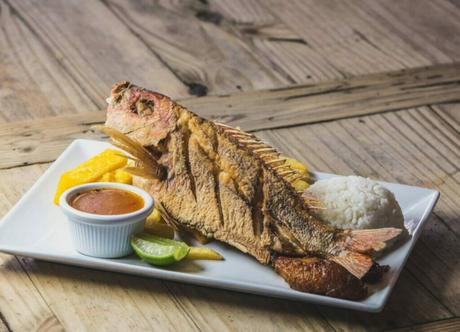
Aruban cuisine reflects its multicultural history, with Creole dishes like Keshi Yena (stuffed cheese) and seafood staples like Red Snapper dominating the menu. International, Asian, and European cuisines also have a strong presence, thanks to the island’s diverse inhabitants.
St. John’s cuisine is a blend of Caribbean flavors, with dishes like Callaloo (a leafy green stew) and Johnny Cakes being local favorites. Fresh seafood is a staple, and the influence of African, European, and East Indian flavors can be savored in the island’s unique dishes.
Food trucks, beach shacks, and high-end restaurants in Aruba offer a varied gastronomic experience. The island’s Dutch influence is noticeable in bakeries and cheese shops, while local markets provide a taste of the island’s fresh produce and specialty items.
St. John’s gastronomic scene offers an array of options, from local eateries serving home-style Caribbean dishes to upscale restaurants offering gourmet cuisine. Food festivals, like the St. John Food Fair, are perfect opportunities to sample a variety of local dishes.
Exploring Nature and Outdoor Adventures: Aruba vs. St. John

Aruba’s Arikok National Park covers nearly 20% of the island, offering hiking trails through its unique desert landscape, with caves, indigenous rock art, and endemic species to explore. Flamingo watching at Renaissance Island is another unique natural encounter Aruba offers.
St. John, with most of its area being a National Park, provides a plethora of nature-based adventures. Hiking trails through tropical rainforests lead to historical ruins, petroglyphs, and panoramic viewpoints. Its coral reefs are a snorkeler’s paradise, and the island’s abundant birdlife is a treat for birdwatchers.
Off-road adventures to Aruba’s natural pool, horseback riding along its rugged coastline, and kite surfing on its choppy waters offer thrilling outdoor experiences. Aruba’s commitment to sustainability is evident in its protected marine parks and nature reserves.
St. John’s outdoor adventures include boating to secluded coves, kayaking in bio-luminescent bays, and stargazing at night. The island’s commitment to preserving its natural heritage ensures sustainable and responsible tourism practices.
FAQ
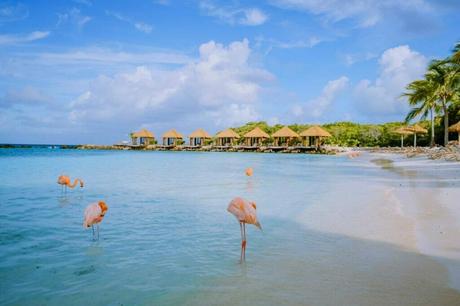
Which island is the nicest U.S. Virgin Island?
St. John is widely regarded as the nicest U.S. Virgin Island. Known for its pristine beaches, lush tropical landscapes, and tranquil atmosphere, St. John offers a breathtaking natural setting. With over 60% of the island covered by the Virgin Islands National Park, visitors can explore unspoiled beauty and enjoy outdoor activities like hiking, snorkeling, and beachcombing. St. John’s commitment to preserving its natural heritage and limited development contributes to its reputation as the nicest U.S. Virgin Island.
What are the 3 main islands of the Virgin Islands?
The 3 main islands of the Virgin Islands are St. Thomas, St. Croix, and St. John. St. Thomas is the most developed and populous, known for its vibrant capital, Charlotte Amalie, and bustling cruise port. St. Croix is the largest of the three and offers a mix of historical sites, beautiful beaches, and a rich cultural heritage. St. John, the smallest of the three, stands out for its pristine natural beauty, tranquil ambiance, and the majority of its land being protected as the Virgin Islands National Park.
Is St. John a US territory?
Yes, St. John is a part of the United States territory known as the U.S. Virgin Islands. The U.S. Virgin Islands is an unincorporated territory of the United States located in the Caribbean Sea. St. John, along with St. Thomas and St. Croix, comprises the main islands of this territory. As a U.S. territory, the U.S. Virgin Islands follows U.S. laws and uses the U.S. dollar as its currency.

